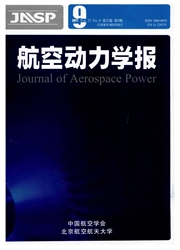

 中文摘要:
中文摘要:
针对超燃冲压发动机中,三面压缩进气道激波/附面层干扰诱发的隔离段流向涡现象,探索了不同的附面层抽吸方式对隔离段流向涡的影响.结合附面层油流图谱及数值模拟考察了相应附面层流态,并分析了不同抽吸工况下的抽吸流量及其对出口截面总压恢复与流向涡的影响.发现隔离段流向涡气流主要源于侧壁附面层分离,相比于再附区抽吸,分离区抽吸大幅度抑制了侧壁附面层的分离流动,从源头上控制了隔离段流向涡的形成,大幅削弱了流向涡尺度,提高了进气道总压恢复.同时,抽吸面积越大,流动品质的改善作用就越明显,但是也伴随着流量损失.
 英文摘要:
英文摘要:
Various methods of boundary layer bleeding were investigated to control the streamwise vortices generated by shock/boundary layer interaction in the isolator of three-dimensional compression hypersonic scramjet inlet. The boundary layer flow patterns were visualized by oil dot technique and numerical simulation. And the effect of different bleedings on inlet performance was then analyzed. It was revealed that the streamwise vortices were mainly attributed to the boundary layer separation on the sidewall, and the bleeding on the sidewall separation is effective. Compared to the bleeding around the attachment line, the bleeding on the separation zone remarkably reduced the boundary layer separation and ef- fectively diminished the development of the vortex structure, which ultimately contributed to higher total pressure recovery at the inlet exit. Moreover, the flow uniformity was improved as the bleeding area increasing, while at the cost of more mass loss.
 同期刊论文项目
同期刊论文项目
 同项目期刊论文
同项目期刊论文
 Effect of humidity on microstructure and properties of YBCO films prepared by Electron Beam Coevapor
Effect of humidity on microstructure and properties of YBCO films prepared by Electron Beam Coevapor Laser induced breakdown spectroscopy for local equivalence ratio measurement of kerosene/air mixture
Laser induced breakdown spectroscopy for local equivalence ratio measurement of kerosene/air mixture Study of turbulent heat transfer of aviation kerosene flows in a curved pipe at supercritical pressu
Study of turbulent heat transfer of aviation kerosene flows in a curved pipe at supercritical pressu Development of integrated high temperature sensor for simultaneous measurement of wall heat flux and
Development of integrated high temperature sensor for simultaneous measurement of wall heat flux and A Compact Sensor Based on Near Infrared Absorption Spectroscopy for Flow Diagnostics in a Low Densit
A Compact Sensor Based on Near Infrared Absorption Spectroscopy for Flow Diagnostics in a Low Densit Numerical investigation on unsteady shock wave reflections over three dimensional intersecting wedge
Numerical investigation on unsteady shock wave reflections over three dimensional intersecting wedge 期刊信息
期刊信息
